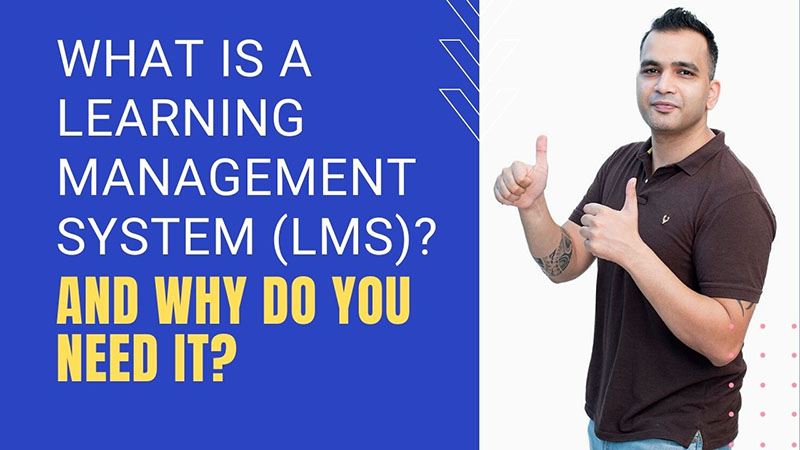What is a LMS and Why do you need it to host your online courses?
LMS stands for a Learning Management System which is a software application that helps you store your online course and deliver the content to your students.
Basically, think of it like a platform to host your online course.
Some of the popular LMS companies include Teachable, Thinkific, Kajabi, Podia, etc.
These companies will charge you a monthly fee to host your online courses and can often be quite expensive.
Now first of all, you may ask me – Kush, Why can’t I just put the course content on my website?
Before I answer that question, let’s understand what exactly do we mean by hosting an online course.
Let’s say you have developed an online course which has 30 videos.
Now there are two things you need to do before you can start selling your online course.
First of all, you need a place to upload your videos. For example, you can upload your videos on websites like YouTube or Vimeo. Both these websites give you the option of uploading your videos as private videos so the general public cannot access them.
Never make the mistake of uploading the videos on your own website using the WordPress dashboard because that would slow down your website to the point that it will take ages to load because every time your student would access the page where the video is uploaded, they would have to basically wait till the video downloads from your hosting server. Most hosting servers won’t even allow your website to have that much space so you’ll get an error message even before you upload.
So one thing is clear – We need a separate place to upload our videos like YouTube or Vimeo.
Now comes the second part.
Once you have uploaded the videos, you need a platform where you can embed these videos and then give your students access to this platform once they have paid you.
Now you can embed these videos to your website. But the problem with that is that anybody with the link of the page where you embedded these videos can share that link with other people and that would mean your course content will get distributed for free.
This is where a LMS comes into play. You will embed the videos inside the LMS system just like you would have done on your own website. But the difference is that the LMS system will generate a login ID and password which your students will get after making the payment. They will need to enter this unique login ID and password to access the page which contains the videos. So they cannot share the link with anyone else. Because if they do, the other person will not be able to access the page since they would also need a login ID and password.
In fact a LMS will even provide you the option to upload the videos directly on its platform so you won’t have to upload the videos on YouTube or Vimeo. Though some LMS platforms can charge you on how much bandwidth your students consume, so in that case you can upload them on other platforms like YouTube or Vimeo and then embed those videos inside the LMS.
For example, to host my main course Online Course Blueprint , I use a LMS called Spayee, which is an Indian company. Spayee is actually much cheaper as compared to the other LMS companies I mentioned above. But the issue is that Spayee charges for bandwidth usage. So what I do is that I upload my videos on Vimeo first and then embed them on Spayee so I don’t have to pay for bandwidth usage since the videos are not on Spayee’s servers.
The reason I use Vimeo and not YouTube is because Vimeo offers more security when it comes to embedded videos. Embedded YouTube videos can be easily shared as their links are visible. But for this you need to Use Vimeo Plus, which is a paid feature. But it’s a small cost which makes your videos very secure.
Now here is the important thing. One of the most vital things to look out for when selecting an LMS is to see how well it integrates with Indian payment gateways. That’s because if you are selling your online courses to Indian audience, you need to offer them different payment options to make sure your conversions don’t decrease.
This is one of the reasons why I chose Spayee. Because they directly integrate with Instamojo, the number one payment portal in India.
If I were to use a more popular LMS company like Teachable, I would be forced to accept payments in a very limited form since this company is from US and they mainly cater to international payment options like Credit Cards. This can massively decrease your conversions since not all your students might have the ability to pay via credit cards.
There is still a way out which is by using a software like Zapier. Zapier does the job of integrating mutiple apps. For instance I can integrate Teachable with Instamojo and then I’ll be able to receive payments from Instamojo payment portal and after a successful payment, the students will be enrolled directly into my course on Teachable. But there’s a catch – Teachable only allows you to use Zapier if you go for their PRO plan, and not their BASIC plan. Their PRO plan costs $119 per month at the time of writing this article. In addition to that you’ll also have to have a paid account with Zapier if you are getting many enrollments. So your costs can skyrocket.
With Spayee, they have a direct integration with Instamojo so I don’t have to use Zapier.
Now having said all that, I’m still evaluating how well Spayee performs when it comes to my students. If I feel I’m getting complaints from my students, then I don’t mind changing over to a more popular platform like Teachable or Thinkific.
I’ll update you on this as and when I learn more.
I also plan to actually show you how to use Zapier to integrate multiple apps in a future article or video because it’s a fabulous app. I’m currently using it integrate Instamojo with my email marketing software.
But as of now, all you should understand is that you need a LMS to make sure your course is hosted in a secure manner. That’s the most important thing.
If paying for an LMS is out of budget for you, what I suggest is that you use a free method to host your online courses like I show in Online Course Blueprint in Module 4 where I talk about hosting courses in detail. And then once you know your course is selling, you can always shift over to using an LMS.
I hope this article helped you. If you have any questions, do ask me in comments and I’ll be glad to help you out.
**UPDATE (25th September 2020) – While browsing the internet today, I came across a Google ad by a company called Learnyst. Upon researching their website, I was pleasantly surprised to find out that it is an Indian company offering a Learning Management System just like Spayee. It’s based out of Bangalore. I went through their website thoroughly and also their social media posts and their blog. And it all seems very good. They also have some well known clients. As of now, seems like a solid alternative to Spayee as the costs are similar. Their overall website looked much better than Spayee. I will be researching more about them and in case I write a detailed post about them, I’ll mention it here.








Sir
I regularly read your write ups. Help me start an online business from.scratch. I have little knowledge and am.confused from where to start.
Hi Prakash, you can join me in my webinar which is taking place on this coming Sunday from 3 PM to 6 PM. You can see the details by clicking here.
Hello sir, it was nice reading the article. I have a plan to start online training but I don’t know how can I start. Though I have some plans, don’t know how to execute them. Can you help me out.
Hi Shobha. I’m glad you liked the article. You can join me on a live webinar which I’m doing this coming Sunday where I’ll be explaining how to start an online course business. You can see the details by clicking here.
hi buddy,
it was nicely narrated. almost all intricacies and doubts that would pop out when anyone wanted to get into LMS has been clarified. Thanks – Kalyan
Thanks Kalyan!
Hi Kush,
Saw your click training videos
When is your next course teaching beginning about doing online course ? I am a beginner.
Hi David. We’re having a webinar on how to create and sell online courses on this coming Sunday, 27th September from 3 PM to 6 PM. You can join me for this webinar by registering your seat by using this link
Nicely explained..you have optimized everything for us as always,,..I have read amny blogs of you..while going though your course…on online selling ..it helps lot…thanks again sir..)
That’s great Pranav! It’s great that you are enjoying the Online Blueprint Course.Keep going!
If I host my course on some LMS platform (Spayee, Teachable, etc.), and sold some courses, so do I need to pay for a lifetime to that platform to access the course by students? As the courses should be accessible for a lifetime by students.
Yes, you have to pay them forever. The moment you stop paying them, your account will soon be closed and your students won’t be able to access the courses. You’ll have to then move your courses to another LMS. That’s why it’s a fixed expense.
Hi Kush
I read your write-ups regularly.
I have a website on WordPress. Do you suggest I go for an alternate LMS and not wordpress website for my courses?
I wanted to start a blog on my online courses on my website. How do I do that now?
There are certain LMS like plugins for WordPress. LearnDash is a very popular one but I’ve tried using it and it’s not user friendly at all. I would strongly suggest using an external LMS platform. For creating blog, just head over to the “Posts” option in the menu in the WordPress dashboard and create a new post. That is how you create blog articles.
Hi Sundeep. Some LMS companies have limits on how much video data can be consumed by your students according to the plan you have purchased with the LMS. This applies if you are using the server system of the LMS to upload your videos. So one of the practices to avoid this limit/restriction is to upload your videos on an external platform like Vimeo and then embed the videos in the LMS. This way you are not using the servers of the LMS and their is no limit. I use Vimeo Plus plan (just above Rs.1000/month) for added security and more upload limit/week than the free Vimeo account. But the main thing is security. Vimeo plus makes it very difficult for your embedded videos to be downloaded. Also, initially you can always go with the LMS’s own servers. If you feel the limit is hampering you, then you can go for this strategy of hosting videos externally.